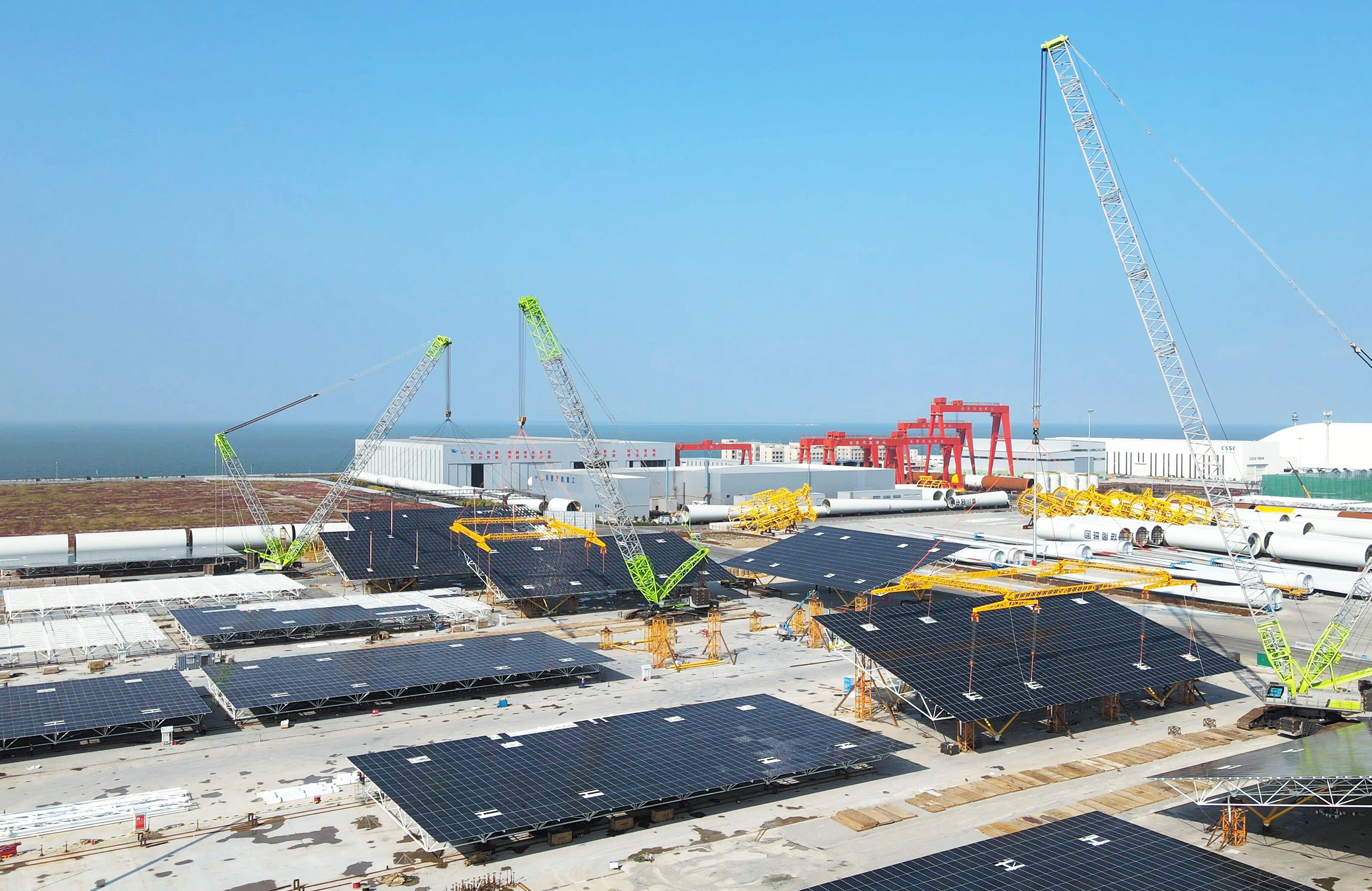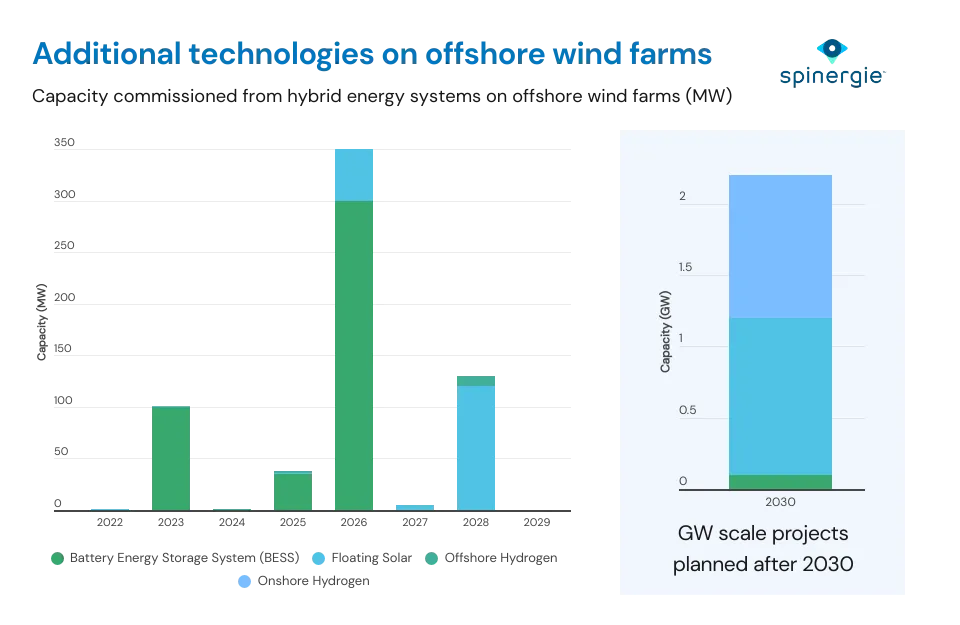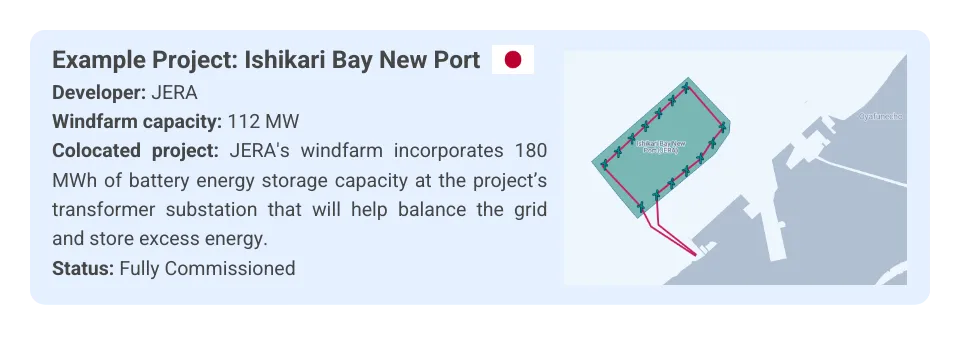Eloïse Ducreux
,
Offshore Sustainability Analyst
Author
, Published on
September 19, 2025
No items found.

The co-location of offshore wind farms with floating solar, battery storage, hydrogen production, and other innovations maximizes ocean space. But these integrated solutions also boost renewable energy efficiency, reliability, and sustainability. Find out more in this insight by Spinergie’s sustainability analyst Eloïse Ducreux.

The co-location of offshore wind farms with other technologies represents an innovative approach to maximizing the use of ocean space. Furthermore, it enhances the efficiency and sustainability of energy systems.
Here, Spinergie’s sustainability analyst Eloïse Ducreux examines how offshore wind farms can be integrated with complementary solutions like floating solar, battery storage systems, and hydrogen production, enabling both energy generation and storage. She will also highlight some emerging applications like wave energy, aquaculture, and offshore charging infrastructure, to demonstrate the potential for multi-use marine environments.

The co-location of floating solar systems and offshore wind farms optimizes energy generation by combining photovoltaic panels mounted on floating platforms with wind turbines. This simplifies grid connection through the use of shared transmission cables and substations. Meanwhile, energy management systems coordinate power from both sources, balancing solar and wind generation to ensure stable and efficient delivery.
The floating solar platforms are designed to withstand marine conditions, including saltwater corrosion, strong winds, and waves, making them suitable for offshore deployment.

Battery Energy Storage Systems (BESS) co-located with offshore wind farms store excess electricity and release it during low wind or high-demand periods. These systems are placed onshore near grid connections to simplify maintenance and grid access and typically use lithium-ion batteries.
Advanced energy management systems optimize the interaction between turbines and batteries, ensuring efficient storage, controlled discharge, and reliable grid integration.
*Note: Curtailment deliberate shutdown refers to the deliberate reduction, or shutdown, of electricity generation from wind turbines, even when they could be producing power. This typically occurs when the supply of electricity exceeds demand or when the grid cannot accommodate additional power due to capacity or stability constraints.

Co-locating hydrogen production with offshore and onshore wind farms leverages wind energy to power electrolyzers that split water into hydrogen and oxygen. Offshore production directly integrates electrolyzers at sea, often on platforms shared with wind turbines. This reduces the need for extensive power transmission infrastructure.
Onshore production utilizes electricity transmitted from offshore wind farms to electrolyzers located at quay. Both setups use advanced control systems to align hydrogen production with wind generation, maximizing efficiency and minimizing curtailment of excess wind energy
In addition to offshore wind projects integrating hydrogen production, many initiatives are led by hydrogen-focused companies aiming to leverage offshore renewable energy for green hydrogen production.
Industrial players are developing projects to use offshore wind power for electrolysis, ensuring a low-carbon hydrogen supply. Notable examples include AquaVentus in Germany and the Dolphyn Hydrogen project in the UK, both leveraging Northern Europe offshore wind to produce low-carbon hydrogen. These projects illustrate a growing trend among hydrogen players to secure dedicated renewable energy sources and scale up green hydrogen production.

Co-locating offshore wind farms with aquaculture can optimize the use of marine space while supporting sustainable food production. Wind farm structures can serve as natural habitats for marine species, improving biodiversity, while also protecting aquaculture operations by reducing wave intensity.
In Taiwan, the Floating Offshore Wind and Fishery Integration Pilot demonstrates this concept. The project combines offshore wind turbines with oyster farming, proving that such setups can benefit local fisheries while producing renewable energy.
Integrating offshore wind with wave energy improves energy supply reliability by leveraging complementary resources. Mocean Energy (UK) has developed wave energy technology designed to operate alongside offshore wind farms. Their systems convert wave motion into electricity, creating a hybrid generation model that increases overall energy output and enhances grid stability.
Developed by a consortium led by Vard Design, Seaonics, and Vard Electro, with partners including Rem Offshore or Equinor, the system has undergone successful prototype testing. The first test demonstrated the charging of the diesel-electric hybrid CSOV REM Power directly from an offshore wind turbine at the Metcentre windfarm.
Offshore wind farms co-located with charging infrastructure for vessels, such as crew transfer vessels (CTVs) and service operation vessels (SOVs), reduce the need for these ships to return to port for refueling, improving operational efficiency and cutting emissions. The Ocean Charger by Seaonics, for example, enables diesel-electric vessels to recharge directly from offshore wind turbines.
Read More: Offshore charging is leading the next wave of vessel electrification

%20(1).jpg)
How Sub-Saharan Africa is driving global crew boat growth, with analysis of rising demand, newbuild orders, and the key players shaping the offshore market.